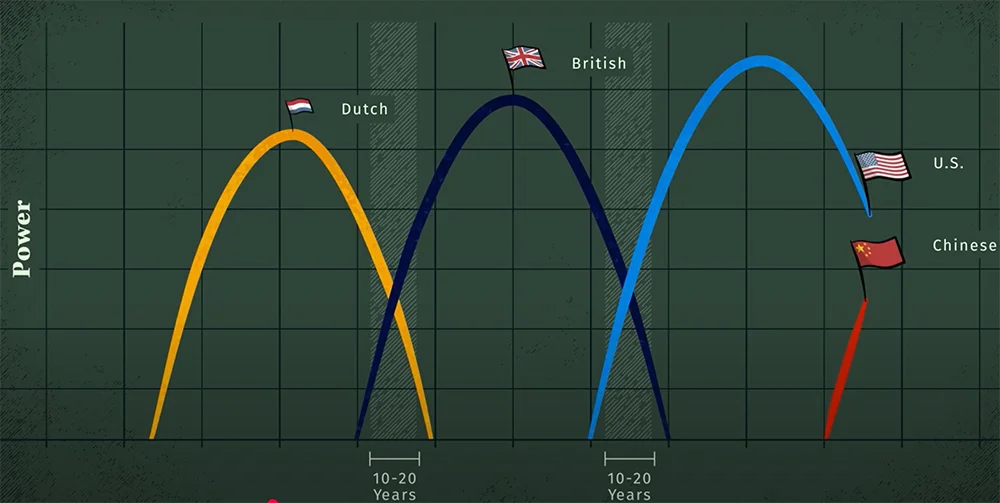How To Preserve Wealth in Alternative and Uncorrelated Assets
You have earned your share of your wealth. But if i can ask you something—how safe is it in the new world, new reserve currency scenario? Are you actually doing everything possible to protect it?
The answer isn’t complicated. “When you want to remain wealthy, you start diversifying.
That means diversification — away from one source of income or from only mainstream markets. Instead, think about real estate, cryptocurrencies, commodities, private equity and other asset classes that don’t go up and down in perfect sync with the stock market.
When executed, these alternatives offer the stability, lower risk, and even higher returns that asset allocators crave.
Here’s what you’ll find in this article:
- Why uncorrelated wealth matters.
- How property investments fit into your portfolio.
- The rise of crypto millionaires—and whether you should join them.
- Why depending on one income source is dangerous.
- And finally, actionable steps to grow and preserve your wealth.
Let’s dive in.

What is Uncorrelated Wealth, Anyway?
Let’s start with the basics.
Consider two people: Person A allocates 100% of their portfolio to tech stocks, while Person B divides theirs between tech stocks, gold, real estate, and private equity.
So who do you think is less at risk?
Right—Person B.
This portfolio has uncorrelated assets, so they don’t go up or down together. Investors sell, but their gold holdings might boom instead if the stock market crashes.
Correlation Measurement
This is where things become interesting. Correlations of assets are a measure between −1 to +1:
- +1 : Perfect positive correlation (assets move exactly the same way).
- 0 : No correlation at all (they behave independently).
- -1 : Perfect negative correlation (one goes up as the other goes down).
Most assets are somewhere in between those extremes. For instance, real estate generally has a low correlation with stocks, so it could be a good source of diversification in any portfolio.
Risk Nullified Through Diversification
Now, why does this matter? Simple math explains it best. Let’s say you own $500,000 worth of stocks, and the market crashes 30%.
All of a sudden you’re down $150,000.” Ouch. But if 50% of your portfolio was in uncorrelated assets like real estate or commodities those losses could be offset — or even turned into gains.
This principle is effective during tempestuous times. During the 2008 financial crisis, many what were supposed to be “uncorrelated” assets became correlated because panicked investors sold, well, everything. But, in the long run, holding a basket of uncorrelated assets does still reduce overall risk.
Volatility Management
Another advantage of uncorrelated assets? They help manage volatility. It’s sort of like driving a car. Imagine without shock absorbers—you’d hit every bump and be thrown off! Likewise, uncorrelated assets are shock absorbers in your portfolio, tempering wild price swings.
For example, when stocks are falling, your real estate investments may be stable — or even be appreciating. Meantime, commodities including oil or precious metals could rise on supply shortages or inflation concerns. It’s all about balance.
Higher Risk-Adjusted Returns
Now you might be wondering: Does uncorrelated assets help improve my returns? Yes! Here’s why:
- By mixing together assets with different levels of risk, you get a much better portfoli
- Lower-risk assets smooth your returns without sacrificing too much growth potenti
- There’s upside if conditions are favorable for risk assets.
In other words, uncorrelated assets provide better risk-adjusted returns.
Examples of Uncorrelated Assets
Uncertain what constitutes an uncorrelated asset? Here are a few examples:
- Real Estate : Residential, commercial, or agricultural properties.
- Commodities : Gold, silver, oil, natural gas, etc.
- Private Equity : Investments in startups or established companies outside public markets.
- Cryptocurrencies : Bitcoin, Ethereum, and others (more on this later).
- Hedge Funds : Specialized funds designed to exploit market inefficiencies.
But take note — correlations aren’t fixed.
They shift with economic cycles, geopolitical events and investor behavior. So check in on your portfolio regularly to make sure it remains balanced.
Property as an Asset Class
If there’s one thing that most dots of wealthy people agree on, it’s that real estate is one of the best ways to build legacy wealth.
The land, houses or commercial space offers an edge over other asset classes, from buying homes to flipping houses, there are unique benefits to holding property that are not available in other asset classes.
Property as an Asset Class
In hindsight, real estate has been a great performer overall.
Studies suggests, annualized total real returns also for residential real estate experience a range from 2.3% to 4.5%. Although these numbers might sound tame next to stock market highs, they signify steady, predictable growth — a key element during uncertain times.
Agricultural real estate behaves similarly and serves as yet another means of diversifying. In addition, both property types appreciate faster than inflation, preserving purchasing power for years ahead.
Global Market Size
Real estate isn’t big; it’s gigantic.
From Manhattan skyscraper to Iowa farmland, a global real estate market worth trillions. It is, in fact, responsible for almost 70% of global household wealth, according to McKinsey & Company.
This huge size makes real estate a key investment for both institutional and individual investors. Even pension funds and sovereign wealth funds devote substantial portions of their portfolios to real estate.
Inflation Hedge
One of the biggest selling points of real estate is its ability to hedge against inflation. As prices increase, property values and rents follow. This combined effect keeps your wealth level — or even increases it — in relation to inflation.
So, if inflation raises prices 5% but your rent climbs 6%, you gain ground. Contrast that with sitting in cash, which withers away in similar conditions.
Thus, it shows diversification benefits which reduce overall risk.
As noted previously, real estate has a low correlation with other financial assets. This quality makes it excellent for improving returns while lowering portfolio risk.
Let’s say this happens: Your stock portfolio loses 20% on account of a market correction.
Meanwhile, your rental properties put off consistent cash flow. Not only do you not panic sell, you also have funds to reinvest at bargain prices.
Evolving Market
Here are a few ways technology is changing the real estate industry. Tokenization and fractional ownership are iconic innovations that have opened up high-value properties to a wider audience, even if you don’t have the millions needed for a straight purchase.
These advancements have democratized wealth creation, enabling ordinary investors to participate alongside billionaires.
With a proven track record helping clients invest in UK property, at LeoZane invest we know our stuff. We do acquisitions, settlements and planner specialist which help you maximize returns. If you’re thinking about growing your real estate portfolio, give us a call—we’re here to help!
The Rise of Crypto Millionaires
Love it or hate it, cryptocurrency has upended the rules of wealth creation. Once viewed as a niche hobby, digital currencies are now making headlines worldwide. And guess what?
Millions of crypto millionaires have already been made.
Here’s a look at what the game board looks like right now:
- As of 2024, there are 172,300 crypto millionaires globally, up 95% from 2023.
- Bitcoin alone boasts 85,400 millionaires, representing an 111% surge.
- There are now 325 crypto centi-millionaires (those holding $100 million+) and 28 billionaires.
- Millennials lead the charge, accounting for 57% of U.S. crypto ownership despite being only 30% of the adult population.
These numbers paint a persuasive picture. Cryptocurrency is not a passing trend — it’s a legitimate route to wealth for millions.
Market Growth
Explosive market growth is fueling this trend. In 2024, the combined worth of crypto assets made an astounding jump of 89% to $2.3 trillion. Bitcoin, the dominant cryptocurrency, price doubled reaching an all-time high of $73,000.
Several factors come into play:
- Institutional adoption: Firms such as Tesla, PayPal and Square now accept or invest in cryptocurrenci
- Regulatory clarity: Governments worldwide gradually legitimize crypto through positive polici
- Technological innovation: Blockchain technology is constantly improving, allowing for quicker, cheaper transacti
Should You Invest in Crypto?
Before diving in, make sure to consider the upsides and downsides closely.
On the one hand, the crypto space has unparalleled wealth creation opportunities. On the other, it is being sold with extreme volatility and regulatory uncertainty.
If you choose to get involved, begin in moderation and educate yourself completely. Consider crypto as a part of your overall investment strategy rather than your sole focus.
After all, the mantra of diversification still holds.
The Dangers of Relying on a Single Income Stream
Think about your primary source of income being taken away from you tomorrow. Scary thought, right?
Sadly, this occurs more frequently than you might expect. The Washington Post wrote + that 34% of American households go through a big income change a year. That’s about a third of families experiencing financial instability.
Income Volatility
Not everyone experiences income volatility in the same way. Some bounce back quickly; others fight for years. Try these eye-opening statistics:
- Only 63% of households with income losses avoid financial shortfalls, compared to 72% of those with stable incomes.
- Many Americans live paycheck to paycheck, leaving little room for emergencies.
Without backup plans, even small setbacks can snowball into big crises.
Financial Well-Being
Diversifying income streams to mitigate income volatility. Here’s how:
- Freelancing: Pick up extra work as a freelancer or gig worker on sites like Upwork.
- investment income: Earn money without working in exchange for capital through dividends or interest (on bonds, for instance) or for renting out a property.
- Entrepreneurship: Run a business or sell products and servi
Each additional stream provides a safety net, cushioning blows when one flickers out.
The Steps to You May Want To Start With
You’re acclimated to the need for uncorrelated wealth, property assets, and income payload. But how do you apply these principles?
Here are some action items that build and sustain wealth:
Step 1: Assess Your Current Portfolio
Begin with a review of the investments you already have. Not all clients are correlated, and those who are may accommodate a riskier posture. Try for a combination of the low-, medium- and high-risk options to get the best return and spread the risk.
Step 2: Explore Real Estate Opportunities
it could be single-family houses or live on fractional ownership platforms, it’s all real estate. Top investors work with trusted advisors, such as the team at LeoZane invest, to deploy their capital into deals that make sense with respect to their goals.
Step 3: Dip Your Toe Into Crypto
If you are interested in cryptocurrencies, start small. Do your research projects and only use reputable exchanges. What to keep in mind: Crypto should supplement — not supplant — the bulk of your investments.
Step 4: Develop Multiple Income Streams
Determine skills or passions you can sell. Maybe you love writing, photography, or coding. Monetize your interests and hobbies while holding onto your 9-5 Job or career.
Step 5: Stay Educated and Adaptive
Finally, decide to never stop learning. Constantly changing markets necessitate continuous education. Stay in touch with industry news sources, webinars, and fellow investors.
Final Thoughts
Preserving wealth isn’t rocket science — but it does take discipline and foresight.
You become subsequently positioned for success for the long haul by embracing uncorrelated resources, utilizing the possibility of land and taking the things that cash cryptocurrencies and diversifying the income streams.
At LeoZane invest, we understand that everyone should have access to expert support and resources. If you’re just getting started or want to improve your strategy, our team can help. If you are looking for guidance and support on your path to financial independence, contact us today to learn more about how we can help.
Your wealth is your legacy. Protect it wisely.
FAQs
Are Crypto Millionaires Really Holding Their Wealth Long-Term?
Some do, but many don’t. Cryptocurrency markets are extremely sensitive, and rapid profits can disappear just as quickly.
The trick is to convert some of your crypto profits into safer assets, such as real estate or blue-chip stocks, once you’re able to extract significant returns. That way, you lock your profits in, but still have part of your portfolio in line for future growth.
Should I Just Avoid Stocks If I Want Uncorrelated Assets?
Nope! Stocks are not necessarily evil, they’re just one element in a larger picture. Instead of ignoring them altogether, focus on building a diversified portfolio comprising of both traditional and alternative assets.
It’s sort of like a sports team: You need players who have different strengths to win, and win consistently. Stocks offer liquidity and potential high returns, and uncorrelated assets offer stability.
What if All My Assets Become Correlated in A Crisis?
This is a real concern, particularly in the midst of extreme coincidences like the 2008 financial crisis. In those situations, even so-called uncorrelated assets can start moving in lockstep as panic investors sell everything.
To counter this risk — circles of the sun, hairs on the neck of a cat — schedule a regular portfolio review and chart changes in allocation against the flip of passing months. Also consider holding cash reserves or low-volatility assets, such as government bonds, for further shelter.
Thank you for Reading





